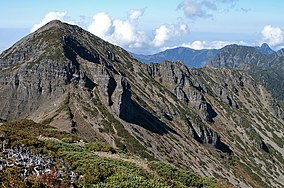Shei-Pa National Park

Multi tool use
| Shei-Pa National Park | |
|---|---|
IUCN category II (national park) | |
 The Holy Ridge, Shei-Pa National Park | |
 Map of Shei-Pa National Park | |
| Location | Taiwan |
| Coordinates | 24°23′13″N 121°08′17″E / 24.387°N 121.138°E / 24.387; 121.138Coordinates: 24°23′13″N 121°08′17″E / 24.387°N 121.138°E / 24.387; 121.138[1] |
| Area | 768.5 km2 (296.7 sq mi) |
| Established | July 1, 1992 |
| www.spnp.gov.tw | |
Shei-Pa National Park (Chinese: 雪霸國家公園; pinyin: Xuěbà Guójiā Gōngyuán; Pe̍h-ōe-jī: Soat-pà Kok-ka Kong-hn̂g) is a national park located in the central part of Taiwan around the peaks of Hsuehshan and Dabajian Mountain, with an area of 768.5 km2 (296.7 sq mi), covering the area of Hsinchu County, Miaoli County and Taichung City. High mountain ecology, geology, topography, rivers, creek valleys, rare animals and plants, and plentiful variety of forest types are some important resources for conservation.[2]
The park's headquarters was set up on 1 July 1992. The current headquarters director is Lin Ching (林青). The address of Shei-Pa National Park is 100 Xueweiping, Fuxing Village, Dahu Township, Miaoli County, Taiwan.
Contents
1 Geography, Climate, and Geology
2 See also
3 References
4 External links
Geography, Climate, and Geology
Shei-Pa National Park is located some 100 km north of the Tropic of Cancer. The park covers a wide range of ecosystems between 760 meters at the lowest point, the Da-an River Valley (大安溪) and 3,886 meters elevation at the highest point, the top of Xueshan (雪山主峰). Xueshan is the second tallest mountain in Taiwan. The Xueshan Range is located along the northern end of Taiwan's Central Range. Like most of the mountains of Taiwan, the Xueshan Range mountains are an uplifted metamorphic belt that makes up the spine of the country. Notable geologic features of the park include the box fold of Pintian Mountain (品田山) as well as many glacial cirques.
The mountains of Shei-Pa cradle the headwaters of several major rivers in Taiwan. The park receives between 1,500 mm and 3,000 mm of rainfall a year and is an important water resource for the country: Takejin Creek flows north to join the Danshui River, which provides water for Taipei. The Dajia River and the Da-an River flow west and north west to provide water to Taichung County. The Touqian River flows northwest to Hsinchu County.
Asteroid 278956 Shei-Pa was named after the national park.[3] The official naming citation was published by the Minor Planet Center on 25 September 2018 (M.P.C. 111804).[4]
See also
- List of national parks in Taiwan
References
^ Shei Pa National Park protectedplanet.net
^ Specer, David (24 November 2017). "Taiwan's Top 10 natural wonders". Taiwan News. Retrieved 27 November 2017..mw-parser-output cite.citation{font-style:inherit}.mw-parser-output .citation q{quotes:"""""""'""'"}.mw-parser-output .citation .cs1-lock-free a{background:url("//upload.wikimedia.org/wikipedia/commons/thumb/6/65/Lock-green.svg/9px-Lock-green.svg.png")no-repeat;background-position:right .1em center}.mw-parser-output .citation .cs1-lock-limited a,.mw-parser-output .citation .cs1-lock-registration a{background:url("//upload.wikimedia.org/wikipedia/commons/thumb/d/d6/Lock-gray-alt-2.svg/9px-Lock-gray-alt-2.svg.png")no-repeat;background-position:right .1em center}.mw-parser-output .citation .cs1-lock-subscription a{background:url("//upload.wikimedia.org/wikipedia/commons/thumb/a/aa/Lock-red-alt-2.svg/9px-Lock-red-alt-2.svg.png")no-repeat;background-position:right .1em center}.mw-parser-output .cs1-subscription,.mw-parser-output .cs1-registration{color:#555}.mw-parser-output .cs1-subscription span,.mw-parser-output .cs1-registration span{border-bottom:1px dotted;cursor:help}.mw-parser-output .cs1-ws-icon a{background:url("//upload.wikimedia.org/wikipedia/commons/thumb/4/4c/Wikisource-logo.svg/12px-Wikisource-logo.svg.png")no-repeat;background-position:right .1em center}.mw-parser-output code.cs1-code{color:inherit;background:inherit;border:inherit;padding:inherit}.mw-parser-output .cs1-hidden-error{display:none;font-size:100%}.mw-parser-output .cs1-visible-error{font-size:100%}.mw-parser-output .cs1-maint{display:none;color:#33aa33;margin-left:0.3em}.mw-parser-output .cs1-subscription,.mw-parser-output .cs1-registration,.mw-parser-output .cs1-format{font-size:95%}.mw-parser-output .cs1-kern-left,.mw-parser-output .cs1-kern-wl-left{padding-left:0.2em}.mw-parser-output .cs1-kern-right,.mw-parser-output .cs1-kern-wl-right{padding-right:0.2em}
^ "278956 Shei-Pa (2008 UZ83)". Minor Planet Center. Retrieved 17 October 2018.
^ "MPC/MPO/MPS Archive". Minor Planet Center. Retrieved 17 October 2018.
External links
| Wikimedia Commons has media related to Shei-Pa National Park. |
- Shei-Pa National Park (Chinese, Japanese and English)
This article about a location in Taiwan is a stub. You can help Wikipedia by expanding it. |
This article related to a protected area in Asia is a stub. You can help Wikipedia by expanding it. |
IQ58OXZJ CQedUVcD EklpQQKSadL0bBjRV7KN9YzCB4EqGk6Ih86H e65KnbGwW LX9pWIfV5Q0 PPJ